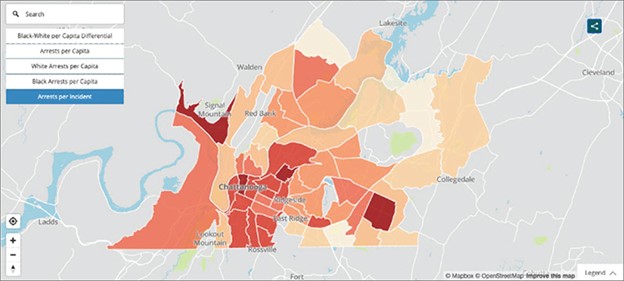Data, Equity, and Policing
November 16, 2021 by Meredith Trimble

Police encounters that result in arrests can have a significant impact on a person’s employment, wealth, and other socioeconomic factors. While national research shows historically oppressed communities of color are arrested and cited at higher rates than their counterparts, the focus is beginning to shift to local analysis.
Today, local governments increasingly want to know the details of law enforcement activities in their communities to ensure equity in public safety for all residents. Chattanooga, Tennessee, is a leading example of using data to inform police equity efforts.
Connecting the Dots
Addressing systemic challenges requires open data as well as civic engagement strategies. Chattanooga is already a leader in both. In practical terms, unpacking racial disparities in policing requires drawing insights and understanding from data to support internal reforms and strengthen community ties in order to decrease the impacts of the public safety and criminal justice systems on communities of color and other vulnerable populations.
The ongoing effort in Chattanooga combines public safety data with census demographics, information on recidivism reduction programs, neighborhood-based planning, and even the local budget. To achieve this holistic analysis, Tim Moreland, Chattanooga’s director of performance management and open data, brought together the right stakeholders for cooperation and access to relevant information.
Developing modeling algorithms and overlaying demographic data helped build the comprehensive view of the local public safety landscape. Resulting analysis aims to illuminate patterns and unearth policies and tactics to adjust. For example, could social services respond to specific types of non-emergency calls, rather than police?
Improved Insights
Chattanooga’s enterprise data platform is key in centralizing, organizing, analyzing, and reporting public safety data. In addition to streamlining data governance, this technology creates a layer of accountability within the police department and with residents, who have access to cleaned, redacted, or aggregated data via the city’s open data portal.
“To provide supported, verified information about how we function as a police department and our impact on those we serve is critical in today’s times,” said Chattanooga Police Chief David Roddy. “The insights and understanding drawn from this data will shape conversations and decisions about how we function as law enforcement.”
Each Monday morning, Chattanooga’s Mayor, Andy Berke, meets with the police chief to review the data dashboard, identify areas for improvements, and iterate on what’s going well.
The dashboard supports the police department in addressing how economic-based citations impact the community, and it sheds light on potential partnerships the police department can form to help solve these issues. In addition, the data is guiding conversations with local pastors, public defenders, and residents.
“It’s about making arrests of people who commit violence, not about surging into neighborhoods that are typically majority Black residents,” Berke said during the National League of Cities 2020 annual meeting. “We want to make sure that we’re using police tactics that don’t let these numbers go out of whack, and having a baseline helps us with that.”

The city’s dashboard includes several maps showing arrest data by census tract, use of force incidents, and racial demographics, which all help provide a lens toward equity. The underlying datasets are automatically updated nightly, and include arrests, citations, police incidents, internal affairs incidents, and more, with some data going back to 2012.
Enhanced Equity, Solutions
The purpose behind driving improved access to insights is to achieve community-level solutions. Insights from accurate, aggregated data are already helping Chattanooga in these specific ways:
- Establishing a baseline to determine which calls for service need an officer
- Informing staffing for the Office of Community Resilience and which calls that team should respond to — for example, public intoxication or overdose calls
- Helping the city establish future-looking plans when it comes to community transparency
- Changing outcomes for the public by diverting people away from the criminal justice system
“I’m hopeful about the future because we have a progressive police department that cares, wants to be trusted by the community, and showed great leadership in getting this data out there,” Moreland said.
Chattanooga’s model is already being replicated and used as an example in other communities that want to create a new vision of justice and public safety that includes everyone.